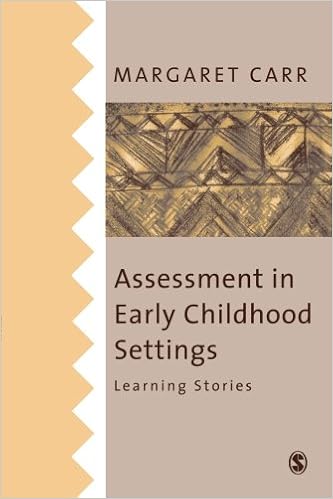Assessment in Early Childhood Settings: Learning Stories
Contents:
I involve my colleagues and the child and his family, seeking their comments and contributions to my observations.
I am confident they will share information and ideas with me, assured that there is always other information out there that can expand and extend an observation. I began to use Learning Stories as a way to approach observation or documentation which recognises this sociocultural approach.

They are written to be shared. The very nature of sharing means transparency and collaboration. Writing a Learning Story is about recognising a good narrative.
It is based upon something which troubles or excites or inspires or disconcerts me. I want to recognise and appreciate the drama and skills, mystery and challenge in what I see and hear.
- Dos and Taboos Around The World!
- .
- Liquide Mittel und Investitionsentscheidungen: Ein optionstheoretischer Ansatz (Beiträge zur betrieb!
- 7 editions of this work.
A baby rolls over and I am suddenly excited. How are we working together? Are Learning Stories the only way to observe and document?
Assessment in Early Childhood Settings: Learning Stories
Documentation intended for sharing is not exclusively reliant on Learning Stories. There are other ways to remember and record important moments and events: A critical analysis of the environment alone is the basis for good documentation and analysis. It may focus on a group activity, and be a learning story about an activity that the children did together such as visiting a fire station or going on a walk.
The Learning Story generally is formulated by the adult to highlight what the child can do and is doing rather than what they can't do. Almost always the adult will take photographs or video to include with the written story, and the written story along with the images will be shared with the child and the child's family.
Refine your editions:
A collection of learning stories is commonly called a 'portfolio'. A portfolio is similar to the traditional photograph album but it is more than an album as it includes the written story behind the the images and may include comments and reflections from the child, family, and ECE service participants.
The physical form of the portfolio may be a book or folder. Alternatively, the video, voice, and images may be loaded directly into an on-line e-portfolio. Learning Stories are said to be suitable for children of all ages, and can become longer and more complicated as the children grow and their skills develop.
Assessment in Early Childhood Settings: Learning Stories [Margaret Carr] on donnsboatshop.com *FREE* shipping on qualifying offers. This book shows that an early. The book is about weaving theory and practice: theorizing development and learning as reflected in assessment practice. The theoretical ideas and arguments are illustrated throughout by transcripts and stories of children in a range of early childhood settings. Dr Margaret Carr is.
They can also be reviewed at a later date in order to help future planning to further develop a child's skills. Usually because they take time to write, Learning Stories are written up after the event has actually happened and when the teacher is not working with the children during a teacher's non-contact time. So teachers need to have a good memory!
- Moon Magick: Myth & Magic, Crafts & Recipes, Rituals & Spells: Myth and Magic, Crafts and Recipes, R;
- mini stories of justice, 7 really scary tales and lots of undeserved consequences!
- A Place for Theodore.
- See a Problem?.
- A Morgadinha dos Canaviais (Portuguese Edition)?
And an accurate memory! Also as explained more below, they need to have had time to get to know very well the individual child they are writing a learning story on, otherwise the risk increases of incorrect assumptions and meanings being ascribed to the child's behaviour, language and learning. While children in early childhood education are not assessed with end of year tests or other formal assessments, the Ministry of Education does require early childhood programmes to be ''informed by assessment, planning and evaluation Supporters of the Learning Story method of assessing children's learning praise the ease of access for parents and teachers because the assessments are written like a story and usually include photos which make them attractive to read, share and keep.
To see what your friends thought of this book, please sign up.

To ask other readers questions about Assessment in Early Childhood Settings , please sign up. Be the first to ask a question about Assessment in Early Childhood Settings. Lists with This Book. This book is not yet featured on Listopia. Andrea rated it it was amazing Dec 03, Rachel Wright rated it liked it Sep 07, Kelly rated it really liked it Mar 17, Hayley rated it it was amazing Aug 27, Julie rated it liked it Nov 07, Sharon Gate rated it really liked it Oct 12, Michelle marked it as to-read Jan 03, Unit 5 added it Jan 14, Jennifer Samantha marked it as to-read Jan 15, Leni marked it as to-read Oct 14,
- Charlottes Lot
- Poems For America
- The Fisherman and the Rhinoceros: How International Finance Shapes Everyday Life
- Applied Medical Image Analysis Methods (Electrical Engineering & Applied Signal Processing Series)
- The Jack Frost Challenge (Fleas Five Christmases Book 3)
- The 30-Day Business Tune Up
- Cómo el MUNDO VERDADERO acabó convirtiéndose en una fábula (Spanish Edition)